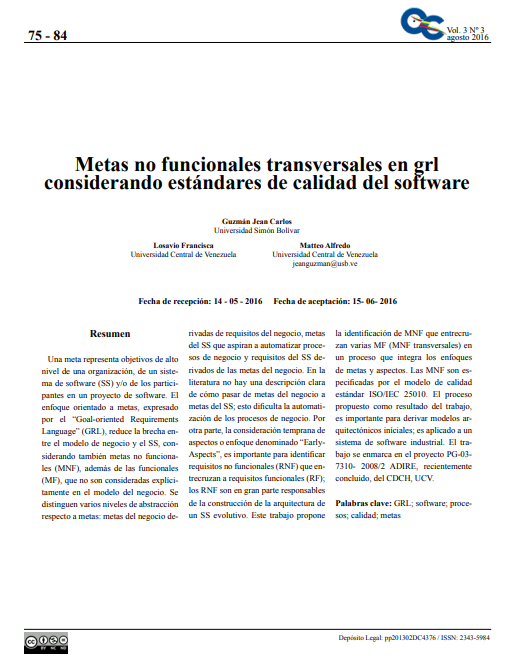Non-functional grl goals considering software quality standards
Keywords:
Goal-oriented Requirements Language (GRL), software, processes, quality, goalsAbstract
A goal represents high-level objectives of an organization, a software system (SS) and/or the participants in a software project. The goal-oriented approach, expressed by the Goal-oriented Requirements Language (GRL), reduces the gap between the business model and the SS, considering also non-functional goals (MNF), in addition to the functional ones (MF), which are not explicitly considered in the business model. There are several levels of abstraction regarding goals: business goals derived from business requirements, SS goals that aim to automate business processes, and SS requirements derived from business goals. . In the literature there is no clear description of how to move from business goals to SS goals; this makes it difficult to automate business processes. On the other hand, the early consideration of aspects, or "Early- Aspects" approach, is important to identify non-functional requirements (NFRs) that intersect with functional requirements (RFs); NFRs are largely responsible for building the architecture of an evolving SS. This paper proposes the identification of NFMs that intersect several MFs (cross-cutting NFMs) in a process that integrates both goal and aspect approaches. NFMs are specified by the ISO/IEC 25010 standard quality model. The process proposed as a result of the work is important to derive initial architectural models; it is applied to an industrial software system. The work is framed in the project PG-03-7310- 2008/2 ADIRE, recently concluded, from CDCH, UCV.
Downloads
References
ITU-T. (2008). User Requirements Notation (URN)-Language Definition: Recommendation ITU-T Z.151. ITU, 2008, pp. 1-206.
ISO/IEC. (2011). ISO/IEC 25010: Software engineering-Software product Quality Requirements and Evaluation (SQuaRE), Qualitymodel, 2011.
Kiczales, G., Lamping, J., Mendhekar, A., Maeda, C., Lopes, C., Loingtier, J. and Irwin, J. (1997). Aspect-oriented programming, Proceedings of the European Conference on Object-Oriented Programming (ECOOP), Vol. 1231, 1997.
IEEE. (2000). Std 1471-2000: Practice for Architectural Description of Software-Intensive Systems, 2000.
Moreira A., Araújo J. and Rashid A. (2005). A Concern-Oriented RequirementsEngineering Model. Advanced Information Systems Engineering, 2005 – Springer.
Lyytinen K., Loucopoulos P., Mylopoulos J. and Robinson B. (2008). Design Requirements Engineering a ten years perspective, LNBIP 14, Springer, 2008.
Losavio F., Guzmán J. y Matteo A., (2011). Correspondencia Semántica entre los lenguajes BPMN y GRL, Revista Venezolana de Información, Tecnología y Conocimiento, Enl@ace, 8(1)11-29, Enero-Abril 2011.
Chung, L., (1991). Representation and Utilization of Non- Functional Requirements for Information System Design, in Proc. CAiSE 91, 3rd Int. Conf. Advanced Information Systems Eng., Trondheim, Norway, May 1991, Berlin: Springer-Verlag, 1991, pp. 5-30.
Mussbacher, G. (2010). jUCMNav. WebHome, , http://jucmnavsoftwareengineering.ca/ ucm/bin/view/ProjetSEG/ Losavio F., Chirinos L., Matteo A., Lévy N., Ramdane-Cherif
A. ISO quality standards for measuring architectures, Journal of Systems and Software 72 (2004) 209-223.

Downloads
Published
How to Cite
Issue
Section
License

This work is licensed under a Creative Commons Attribution-NoDerivatives 4.0 International License.







